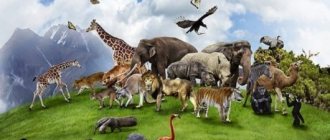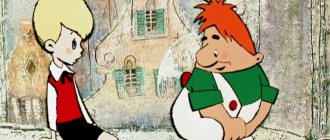It’s hard to imagine, but every 60 minutes three species of animals become extinct on our Earth, and over the past couple of decades we have already lost almost a third of the existing diversity of our smaller brothers. The World Wildlife Fund (WWF) never tires of drawing public attention to these and other shocking facts. It is no coincidence that World Animal Day, which falls on October 4, has long turned into a holiday with a tinge of sadness - for those four-legged, tailed and feathered animals that we may no longer see even on the most exotic safari. But, at the same time, it is also a celebration of hope - that by listening to the problems of the animal world, humanity will soon be able to eradicate cruelty to animals, and endangered species will be saved.
The history of International Animal Day
The tradition of celebrating World Animal Day (or, in other words, Animal Day) arose in the last century - more precisely, in 1931, in Florence, in accordance with the decision of the International Congress of the Movement for the Protection of Wildlife. Moreover, it was proposed to celebrate on October 4, since this date falls on the day of remembrance of St. Francis of Asiz, whom the Catholic Church reveres as the patron saint of animals. Throughout his life, Saint Francis actively helped all those in need, and first of all, our little brothers.
In our country, St. Francis Day on October 4, best known as Animal Protection Day, came not so long ago - in 2000, at the proposal of the International Fund for Animal Welfare. The holiday quickly caught on, which is not surprising, because our country has long been ranked second in the world after the United States in terms of the number of pets: beloved pets of all kinds live today in every third Russian family.
Musk deer
Image source – Wikipedia. Author: Nikolay Usik / https://paradoxusik.livejournal.com/ - own work, CC BY-SA 3.0, https://commons.wikimedia.org/w/index.php?curid=23003947
The artiodactyl resembles a deer, but the characteristic feature of males is not horns, but long protruding fangs like a saber-toothed tiger. And despite the carnivorous teeth, the animal is completely harmless - it feeds exclusively on vegetation.
In Russia, the musk deer lives in Eastern Siberia and Sakhalin. The animal loves rocky terrain and coniferous forests. Surprisingly, in search of food, the musk deer jumps along tree branches and can even climb the trunk. In general, musk deer are among the first in athletics among all artiodactyls. They are capable of making unusually high jumps. And when hiding from a predator, animals can confuse their tracks and make unusually sharp turns while running.
Interesting fact:
Moschiferus - the name of the species in Latin - translates as "bearing musk"; It was precisely because of this substance that musk deer often became victims of poachers.
The world community is committed to protecting the rights of fauna representatives
Despite the fact that the problem of the destruction and extinction of animals, as well as the destruction of their natural habitat, has existed for many centuries, people began to take real actions to improve the situation only relatively recently. Moreover, activists of animal rights movements are increasingly drawing public attention to the fact that not only wild animals, but also domestic animals need human participation, since cases of cruelty to them have been increasing recently. It is no coincidence that most European countries have long recognized that pets are a full-fledged part of the family and, as a result, have exactly the same rights as the rest of its members.
pixabay.com/Lepale
An important tool for the protection of rare animals in Russia is the Red Book of the Russian Federation. It includes over 400 species of animals that need protection and are at risk of extinction. These are the polar bear, the Amur tiger, the bison and other well-known representatives of the fauna. In our country, special federal laws, which are constantly being supplemented and improved, are called upon to radically change people’s attitudes towards the environment.
Dressing
Image source – Wikipedia. Author: Laszlo Szabo-Szeley © AVESTOURS — Original uploader was Wgors at en.wikipedia; description page is/was here., Attribution, https://commons.wikimedia.org/w/index.php?curid=3550742
Externally, the animal is very similar to a ferret, but the size of the dressing is slightly smaller. And, by the way, it belongs to the same species - mustelids. The name “bandaging” sounds funny to the Russian ear - we all immediately imagine how a nurse changes the bandages at the site of a fracture. But the predator also has another name - Vormela peregusna.
The animal's very unusual color instantly attracts attention - a black and white muzzle, a rich sand-colored coat with dark spots, as if borrowed from a leopard, and a fluffy motley tail.
But despite such an unusual color, the animal’s fur is not considered valuable by poachers, and this species of mustelids was included in the Red Book for another reason. The steppes, the traditional habitat of bandages, turned out to be the most convenient territory for farming. In addition, due to the mass destruction of small rodents in these arid places, the animals often do not have enough food.
Interesting fact:
The animals behave like skunks if they notice an enemy nearby - they arch their tail towards their head, raise their fur coat on end and release a sharp, unpleasant odor.
Traditions and features of the celebration of Animal Protection Day
Of course, October 4 is primarily a professional holiday for ecologists, zoologists, veterinarians and other specialists whose work is related to helping animals and protecting the environment. However, it is not easy to cope with any task alone, so every year all over the world, societies for the protection of our little brothers organize on Animal Protection Day all kinds of mass events and actions aimed at uniting caring people to solve the problems of the animal world. Similar events are taking place today in more than 60 countries around the world, including Russia, and Animal Protection Day 2021 will not be an exception, despite the difficult epidemiological situation. Charity auctions and other events dedicated to the theme of the holiday will be held around the world. Numerous shelters for homeless animals organize distribution exhibitions on this day. Thousands of volunteers will take part in festive marches and fundraisers in support of our little brothers. After all, World Animal Day is still a very modest, but at the same time, a very significant contribution from each of us to the noble cause of preserving the animal world. Love our little brothers!
pixabay.com/
Narwhal
Image source – Wikipedia. Author: press service of Gazprom Neft PJSC – https://media.gazprom-neft.ru/pictures/regions/nature/category1436/2019-06-11_19-19-46__1_.jpeg.htm, CC BY-SA 4.0 , https://commons.wikimedia.org/w/index.php?curid=80649069
Another animal whose name the Russian language teacher can take note of if children are doing a project on homoforms. But not only the name is unusual - the marine mammal looks like a animated picture from the brush of a science fiction artist: a large whale with an oblong body shape is equipped with small fins and a small tail, and on the muzzle (usually only males) there is a long sharp horn. Whales become unicorns when they mature: one of the upper teeth tends outwards and grows into a huge spiral-shaped tusk.
Narwhals love coolness and freshness, and therefore live in the chilly waters of the Arctic. Near the Russian coast, animals can be seen (if you are very lucky) near Bering Island, in the White Sea and the waters along the Murmansk coast. Whales are listed in the Red Book of Russia and are considered a rare and small species of animals.
Interesting fact:
from the Icelandic language, “narwhal” stands for “corpse” (nar) and “whale” (hval) - the animal was so named because of the unsightly grayish tint and spots on the body.
Additional Information
(folk signs, proverbs, sayings, riddles, short own poems and illustrations, other
)
Folk signs about animals
- A dog whines - indicates someone’s illness.
- A black cat crossed the road - come back, otherwise there will be no luck; so that the omen does not come true, take a twig, break it into two halves and throw them in different directions - open the road; or place the middle finger of the right hand on the index finger; or turn around its own axis and continue in the same direction.
- The cat rests its paws on the window frames and looks out the window - there will be guests.
- If a calico cat crosses the road, it’s no bad thing.
- If a cat runs across the road from left to right, it’s not good, you need to look to the right 3 times, at any tree, and spit 3 times; if she crossed the road from right to left, nothing bad, but just in case, you need to look left 3 times, at the tree, and spit 3 times.
- If a cat runs across the road in front of a cart, everyone sitting in it should definitely wrap their headgear around its axis.
- Luck comes into the house with the frog.
- Dolphins are frolicking - there is a storm. (Sea superstition).
- The horse stumbles under the rider - to failure.
- If a dog howls away from the house, it’s okay; It’s bad for the one in whose direction she howls.
- A hare runs through the village - towards a fire; if he crosses the road, you need to beware of something; To prevent the omen from coming true, you need to roll over three times in that place.
- If a squirrel crosses the road or comes across it, it’s bad luck.
- A horse neighs - good news.
- A horse snorts on the road - to a joyful meeting.
- A fox will come across on the road - bad luck.
- A cat reaches out to a person - towards a new thing; rushes from corner to corner - to joy or to quarrel.
- The cat meows endlessly - expect a child in the family; washes, itches - wait for guests.
Who's celebrating?
Man appeared on earth as one of the species of the animal world. Thanks to the presence of intelligence, he was able to rise to a higher level. And this step allowed the person to feel his superiority. Establishing relations with the “smaller brothers” was ambiguous.
To survive, people had to kill animals. This was justified not only by the need for food, but by the need for protection from predators.
Then a more reasonable approach appeared, when humanity tamed wild animals and learned to breed them and use them as domestic helpers. But the traditions associated with hunting have been preserved for a long time.
Man, as the most dangerous predator, continues to hunt animals and birds today. And if for ancient man this was a justified necessity, then modern hunters act only for their own pleasure.
There are simply barbaric customs. Believe it or not, in Denmark, on the Faroe Islands, all the residents of the surrounding villages gather once a year to kill dolphins. The entire bay turns red with the blood of innocently killed mammals.
Despite the protests of environmental organizations, the madness continues and, in addition, is justified by local customs.
Folk beliefs also played an important role in the extermination of fauna. The purpose of the hunt was to destroy representatives of the “devilish spirit” or sacrifice. Thus, the Bali tigers were completely exterminated by local residents, since they were considered not just dangerous, but a threat to peace of mind.
And, of course, personal gain. Hunters pursued selfish goals for unique skins and tusks, fat, meat and entrails. Exotic lovers pay exorbitant amounts of money to stroke their vanity.
Poaching is the main cause of death of many species of fauna in the modern world. Methods to combat poaching in many countries are prescribed at the legislative level. But for the sake of his own benefit, man finds more and more sophisticated loopholes on how to obtain the coveted animal raw materials.
The rapid development of industry, the expansion of agricultural land, and the growth of cities did not have the best effect on the situation of animals. Pollution of water and air, disappearance of natural habitats, increase in temperature conditions, disruption of biological chains lead to natural extinction.
Only a person can stop this whole process. Of course, it is impossible to talk about human complete indifference to the problems of the animal world. Issues of protection, revival, and humane treatment are raised quite acutely in society.
In addition to the contribution of public environmental organizations, a lot has been done at the state level. Specific police squads have been created whose purpose is to combat poaching. In the open waters, this function is performed by fisheries inspectors.
Scientific laboratories and nurseries have been organized, the purpose of which is to breed rare species of animals. Gamekeepers and foresters work in forest lands, who not only monitor the number of fauna, but also feed the animals and fight poaching. Employees of these organizations can rightfully consider a holiday dedicated to the protection of animals as their own.
No less pressing is the issue of cruelty to pets. A person, having played enough with a living toy, often simply throws it out into the street.
The problem of stray cats and dogs, of course, can be solved through joint efforts. But now, in most cases, this is done by volunteer organizations that find a new home for homeless pets.
Undoubtedly, the activities of public, state, and volunteer organizations make a significant contribution to solving issues of protecting the animal world. But solving them at this level without the participation of every person is unrealistic. Therefore, we can safely say that a holiday dedicated to the protection of the animal world is a day when every caring person should think about what he personally can do for our “younger brothers.”
Disappointing facts: on the verge of extinction
Representatives of the animal world sometimes amaze people not only with their beauty, but also with amazing facts.
It turns out that the best herd guards were not dogs, but quaggas - distant relatives of zebras. Their keen eyes allowed them to notice the approach of predators before anyone else. Passenger pigeons were considered the most numerous birds on the planet. Marsupial wolf cubs spent their first three months of life confined to their mother's pouch. True, interesting facts about unusual animals. Only extinct ones. And this is only a tiny fraction of the information about those copies that are irretrievably lost.
According to the World Wildlife Fund, the animal world has halved in 40 years. Both livestock and entire species disappear. The statistics about freshwater inhabitants are especially alarming. Thanks to human activity, their numbers have decreased by 75%. The situation with “terrestrial” species is not much better. Up to 40% of animal species have been irretrievably lost.
The figures announced by the fund are simply depressing:
- up to 70 species of flora and fauna disappear from the planet every day;
- every 20 minutes the world loses one species of living creature;
- Every second, up to 1.5 hectares of forest plantations are irretrievably lost.
Of course, work is underway to prevent such processes. Protected areas are being created, hunting is prohibited, and lists of rare species are being compiled that, according to the Convention, are subject to protection. But the global nature of the problem allows us to emphasize the importance of the contribution of each person.











